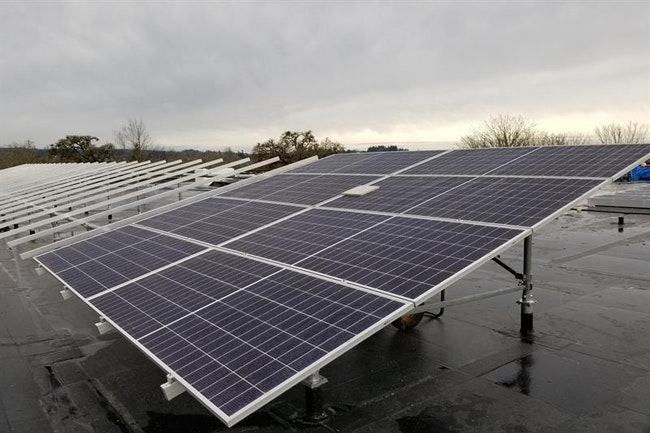
Solar panels on the Salem Public Library roof (Courtesy/City of Salem)
Oregon’s energy sector faces a complex and uncertain future as utilities move away from fossil fuels.
Demand for power could increase sharply as more people move toward electric vehicles and lower-carbon technologies in other sectors, further challenging efforts to keep the grid powered.
Those were the takeaways from a March 18 Salem City Club presentation about the Pacific Northwest’s energy future, featuring John Fazio, senior systems analyst for the Pacific Northwest Power and Conservation Council, and Brett Greene, Portland General Electric’s senior director for clean energy origination & structuring.
Fazio’s role is to help the council analyze future power needs for the Bonneville Power Administration, a Portland-based federal agency and the region’s largest supplier of electric power, chiefly from hydroelectric dams.
Those analyses help the administration determine what new power resources, like wind farms or energy efficiency measures, are needed to meet demand. Fazio said it’s a delicate balancing act made challenging by many unknowns and the impact of policies outside the energy sector.
“The penalties of going either direction are not symmetric. If we overbuild, that means that rates go up and ratepayers get mad. But if we underbuild and the lights go out, they get even madder,” he said at the meeting.
Hydroelectric power makes up about 53% of the region’s energy supply, with wind (17%) and natural gas (12%) next. But coal still provides about 8% of Pacific Northwest power, Fazio said. That will decrease significantly in the coming years as power plants are scheduled to go offline, with about 4,000 megawatts of coal-generated energy being retired by 2030.
Energy efficiency and increased renewable energy will be needed to make up much of the difference. Demand response – policies where utilities incentivize customers to consume less power during high-demand times by increasing rates or limiting voltage – will also be key, he said.
But Fazio said whether power demand falls in the future or grows significantly depends largely on other sectors.
“What happens if we have aggressive decarbonization policies, like some cities are now saying new buildings must be all-electric? What if we have a push for more electric vehicles? Obviously, that’s going to increase the demand. So we understand that there’s a tremendous amount of uncertainty in what might happen in the future,” he said.
Under current policies, Fazio said the Pacific Northwest’s energy sector will decrease its carbon footprint to 17 million metric tons of carbon emissions per year by 2041. That’s about one-third of power-related emissions in 2005.
Fazio said with current technology, there’s no scenario where the region can cut all carbon emissions from its electricity generation by 2050. Demand from electric vehicles and other electric infrastructure further complicates that planning.
“If everybody were to have an electric vehicle, there’ll be so much demand for electricity that we would really be scrambling to find sources for that electricity, and the answer is not just building more wind and solar, because it would not be cost-effective. So there is a challenge in front of us,” Fazio said.
Improved battery storage and other technologies will be key, he said.
Greene addressed how Portland General Electric, Salem’s primary electric utility, is forecasting for its future.
Areas with cheap hydropower are “experiencing a significant increase in demand largely driven by data centers, as well as cryptocurrency companies. So they are now consuming a lot of that hydro resource that we at Portland General have relied on for the better part of 100 years,” Greene said.
But natural gas and coal plants still account for by far the largest share of electricity generated by PGE, Greene said – about 2,138 megawatts total. Of that, only 450 megawatts will be allowed in Oregon past 2030 because of a state law passed last year requiring utilities to reduce carbon emissions 80% by 2030.
The utility has pledged to pay off its 20% share in its last remaining coal plant Coalstrip located in Montana, by 2025.
PGE’s wind-generated power averages about 350 megawatts, and solar about 110, Greene said. That power often isn’t generated when demand is highest, further complicating the picture.
“We’re losing hydro, we are losing access to our thermal fleet. And you have renewable generation that is variable in nature and very reliant on Mother Nature. So that absolutely increases the risk around can we keep the lights on,” Greene said.
He said more distributed generation, like small home solar installations with batteries, will be a key part of the future. Better battery storage will also improve the ability of renewable energy sources to meet demand.
“As technology advances, we can start to pair those technologies with battery storage. So that when that wind and solar generates and we don’t actually need it for consumption, we can store it and then move it later in the day or earlier in the day so that we can move around our demand,” he said.
Correction: This article originally misstated the effect of Oregon’s greenhouse gas reduction law for utilities. It requires utilities to cut carbon emissions 80% by 2030, not to get 80% of power from renewable sources. Salem Reporter apologies for the error.
Contact reporter Rachel Alexander: [email protected] or 503-575-1241.
JUST THE FACTS, FOR SALEM – We report on your community with care and depth, fairness and accuracy. Get local news that matters to you. Subscribe to Salem Reporter starting at $5 a month. Click I want to subscribe!









